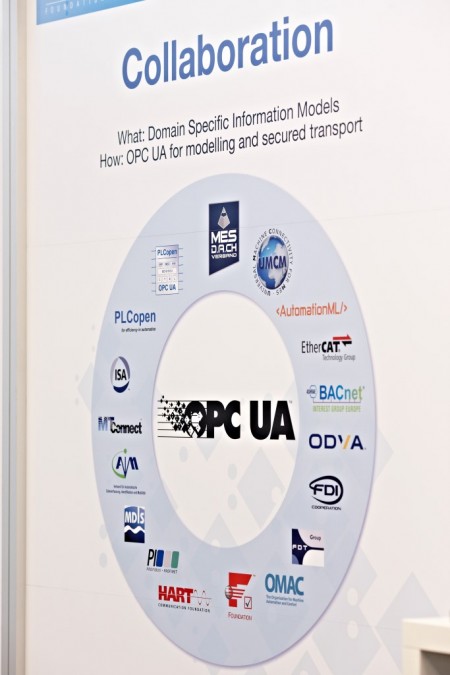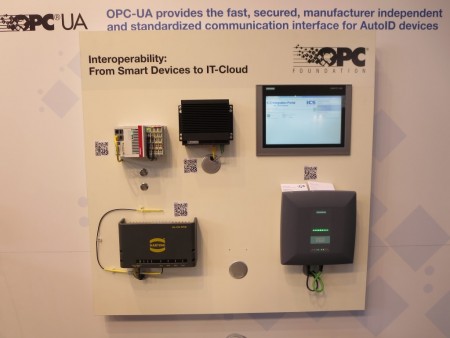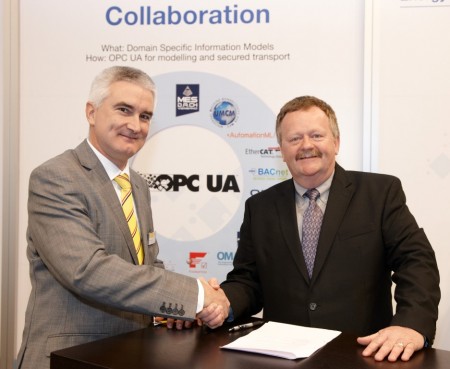 The number of active collaborations with many information modeling organizations and industrial Ethernet organizations has expanded beyond our ability to even keep track. That’s because many of these collaborations are being done independently of any engagement with OPC Foundation staff. Companion specifications for OPC UA are popping out of the woodwork. Everyone wants their technology to leverage the OPC UA platform infrastructure and communication architecture enabling information integration and interoperability from the embedded world to the cloud. For complete information about all of these collaborations I highly encourage you to refer to the OPC Foundation website. Space in the newsletter can’t do justice to communicating all of the markets that OPC UA is the dominant choice for communication and interoperability. That said, here are two recent collaborations which have involved the OPC Foundation staff:
The number of active collaborations with many information modeling organizations and industrial Ethernet organizations has expanded beyond our ability to even keep track. That’s because many of these collaborations are being done independently of any engagement with OPC Foundation staff. Companion specifications for OPC UA are popping out of the woodwork. Everyone wants their technology to leverage the OPC UA platform infrastructure and communication architecture enabling information integration and interoperability from the embedded world to the cloud. For complete information about all of these collaborations I highly encourage you to refer to the OPC Foundation website. Space in the newsletter can’t do justice to communicating all of the markets that OPC UA is the dominant choice for communication and interoperability. That said, here are two recent collaborations which have involved the OPC Foundation staff:
OPC Foundation and AIM Partner on AutoID Integration
The AIM German industrial association and the OPC Foundation have announced the introduction of the OPC AIM Companion Specification for simplifying the integration of AutoID systems with IT systems. First revealed at Hannover Messe in April 2015, the specification is designed as an essential component for the successful integration of AutoID for the Industrie 4.0 concept.
AIM represents the global network of AutoID experts. AutoID systems facilitate automatic identification of the parts and transport items in industrial processes that are increasingly being enhanced with sensors and Real-time Locating Systems (RTLS).
 OPC Unified Architecture (OPC UA) and OPC specifications are vendor-independent and platform-neutral tools. Their objective is to integrate production control with leading IT systems. The new specification will enable faster integration of AutoID and IT systems in all application fields.
OPC Unified Architecture (OPC UA) and OPC specifications are vendor-independent and platform-neutral tools. Their objective is to integrate production control with leading IT systems. The new specification will enable faster integration of AutoID and IT systems in all application fields.
AutoID systems use barcodes, two-dimensional codes, RFID, NFC, RTLS, sensors and other technologies. They are necessary components for the successful control of processes in production and in material flow and logistics chains. They also provide important data for leading software systems, including Manufacturing Execution Systems (MES) and Enterprise Resource Planning (ERP).
AutoID system integration is fundamentally significant for realizing global concepts like “Internet of Things” and “Industrie 4.0″, also in combination with Cyber Physical Systems (CPS).
Olaf Wilmsmeier, Product Manager Software with the Harting Group, Espelkamp, and AIM Germany board member, emphasizes: “After a year of intensive co-operation between OPC UA and AIM experts from renowned companies in the AIM Germany System Integration Working Group, we announced the first version of the AIM OPC Companion Specification at Hannover Messe. So far, for example, AutoID readers for barcodes and RFID to a large extent are vendor-specifically connected to leading software systems. With the new OPC AIM Specification we provide the market with a manufacturer-independent standard for integrating AutoID systems faster and cheaper.”
Stefan Hoppe, Vice President, OPC Foundation, explains: “The OPC Foundation goal is to create an industrial standard for horizontal and vertical integration from sensor to the IT enterprise level. The OPC Unified Architecture was originated in industrial automation but is meanwhile also being used in other vertical markets. OPC UA has been set as communication technology as part of the reference architecture for Industrie 4.0 – controlling transport of data and information with integrated mechanisms for system security and access.
“Interesting for other organizations are the OPC UA modelling capabilities which help describe what needs to be transported,” adds Hoppe. “The AIM Germany industrial association recognized early on the OPC UA potential. The implementation of the common specification will strongly lead to simplified and secure connection of AutoID systems with the world of control but also direct into the enterprise IT world.”
Automatic Identification and Industrial Automation Go Hand in Hand
The AIM Germany co-operation with the OPC Foundation is based on a common risk evaluation regarding the deficiencies of current system integration in manufacturing, materials flow control and logistics. The new OPC AIM Companion Specification unifies diverging standardization activities and accomplishes a significant value-add for integration projects for users in numerous branches as far as concerned acceleration and cost reduction. The specification is designed to prevent the emergence of diverging and competitive specifications that would irritate users. Obtaining OPC AIM Companion Specification documents requires membership in the AIM association or OPC Foundation.
OPC Foundation and EtherCAT Technology Group Sign MOU
OPC UA is about scalable communication with integrated security by design up to MES / ERP systems and into the cloud, EtherCAT is about hard real-time capability in machines and factory control systems. Both technologies complement each other perfectly.
Industrie 4.0 and Internet of Things (IoT) architectures require consistent communication across all levels while using Internet technologies: both in as well as outside of the factory, for example to cloud-based services. That exactly is what the OPC Foundation and the EtherCAT Technology Group (ETG) want to account for by defining a common definition of open interfaces between their respective technologies.
 At the Hanover Fair Thomas J. Burke, President and Executive Director of the OPC Foundation and Martin Rostan, Executive Director of the ETG signed a Memorandum of Understanding in which both organizations agree to closely co-operate developing these interfaces.
At the Hanover Fair Thomas J. Burke, President and Executive Director of the OPC Foundation and Martin Rostan, Executive Director of the ETG signed a Memorandum of Understanding in which both organizations agree to closely co-operate developing these interfaces.
Tom Burke: “OPC UA has established itself as standard technology for incorporating fieldbus systems in Industrie 4.0 and IoT environments. With EtherCAT Technology Group one of the leading Industrial Ethernet technology organizations, specifically the one with the most members globally has decided for OPC UA. The co-operation between both organizations will soon lead to mature interface definitions, in the way they are being requested by users.“
“We regard OPC UA as an ideal extension to our technologies. EtherCAT is and will stay the technology of choice for high real-time requirements and particularly lean implementation thanks to hardware integration. OPC UA provides a Service Oriented Architecture (SOA) with authentication and secure communication into the cloud and to MES systems. Both standards are open and internationally recognized. Combined they are complete, and as such we look forward to the common interface specification”, adds Martin Rostan.